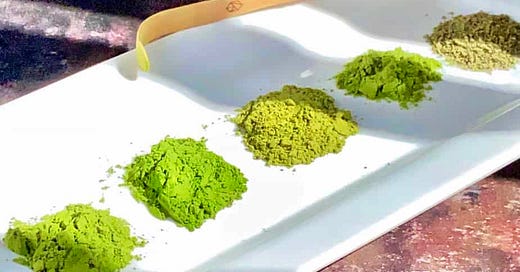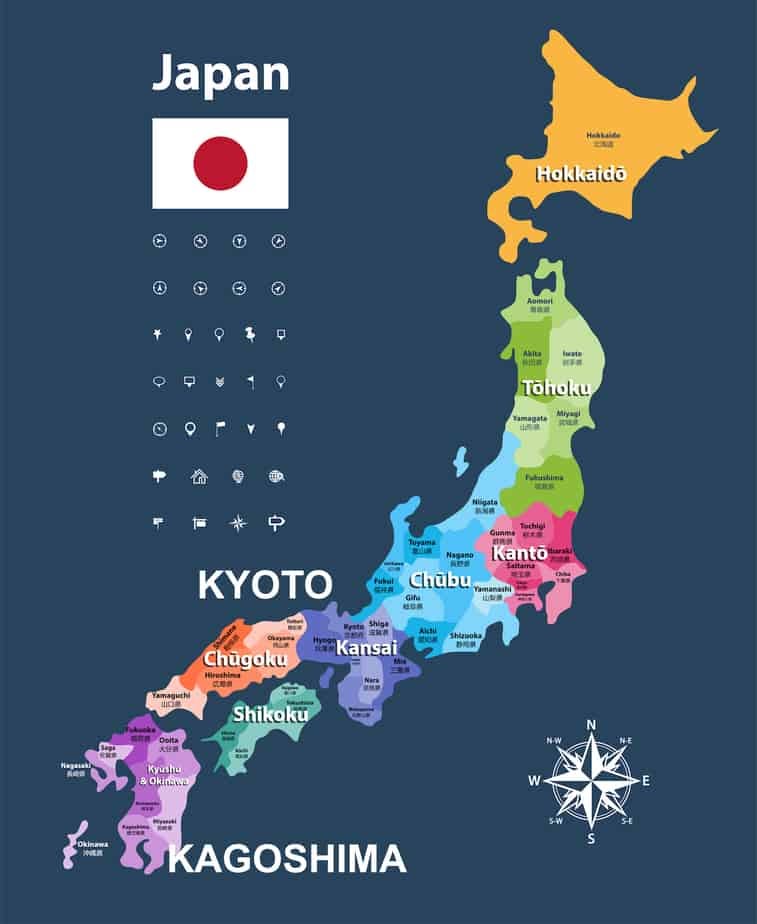Searching for a drink that fuels both calm and focus? Meet matcha—no ordinary green tea. This vibrant powdered tea offers a sustained, attentive energy boost without the usual caffeine jitters. If that sounds too good to be true, think again—this is the power of matcha.
Although matcha is trending in many health circles, it's far from new. The traditional Japanese method of producing and preparing matcha is unique and has been used in tea ceremonies for centuries.
Today’s way of drinking matcha is to consume this green tea leaf powder in a shot glass like an espresso, in a creamy latte, mixed with fruits, or baked in goods. With so many different products on the market and ways to drink them, how do you know which matcha to buy?
I compiled a short guide to selecting the best matcha to get the most out of this antioxidant-rich powdered tea's unique chemistry.
Where the best matcha powder is produced
Traditionally, the best matcha comes from the Kyoto prefecture in Japan. The town of Uji is a key area for matcha production. Kyoto is a historical tea-growing area with many plantations producing tea.
But you can buy excellent matcha from many tea-producing areas in Japan. For example, Pique Matcha is sourced from Kagoshima, the southernmost region of Japan. Kagoshima has 15 tea-growing areas.
Other notable tea-growing areas of Japan include the Shizuoka and Kyushu prefectures. Fukuoka, Saga, and Nishio are all known for producing matcha.
Japanese matcha
Source
When buying quality matcha, you're looking at the color, texture, smell, flavor, and finish in addition to the country of origin. Presently, high-quality matcha is only from Japan. Just as Bordeaux wine is only produced in Bordeaux, France, always buy matcha that is grown and produced in Japan. Any reputable tea vendor will tell you where their tea is sourced.
Color and Texture
Look for a vibrant green color. A dark green, brown, or yellowish hue indicates the leaves are older from the lower portion of the tea bush or the tea itself is old.
Examine the tea powder. It should be finely ground and silky smooth, like flour, not grainy like sugar.
What does matcha taste like?
Smell and Flavor
Matcha should taste good, even a little sweet. If it tastes bitter, it could be due to poor quality or poor brewing techniques. It should be smooth with sweet vegetal notes, not bitter or gritty.
It's easy to see the different grades by looking at the tea powder's color and texture. Of course, the other factor is taste. Not all matcha tastes the same.
Matcha has a weight and viscosity closer to coffee than tea and is often a coffee alternative. It's an approachable tea served hot or cold and sweet or savory.
Green tea powder
Here is a closeup comparison of five different Japanese-grown matchas. Can you tell the difference?
The far left and middle samples are lower-grade matcha, and the other three are higher quality.
From left to right are Lipton Matcha Green tea, Adagio ceremonial grade matcha, Sen Cha Naturals Organic everyday matcha, Pique ceremonial grade organic matcha, and Matcha Organic Japan 001 matcha.
The above photo is just a tiny sampling of the wide variety of matcha on the market today. The hallmark of high-end matcha is its vibrant color, smooth texture, and long finish. You can still taste good matcha a few seconds later on your palate.
The difference between each of these matcha powders
The Lipton Matcha Green tea mixes green tea and matcha powder. It comes in a tea bag. It is mainly cut green tea with very little matcha. The taste is more like green tea than matcha. It leans toward the bitter side, especially if using too hot water. I’m not a fan.
Adagio ceremonial grade matcha is one of my favorites. It's made from the Samidori cultivar from Uji, Japan. It's the one I always return to over again. I enjoy this matcha alone and for mixing small lattes. The taste is smooth and not too vegetal.
The Samidori cultivar is a Japanese tea variety mainly known for its use in producing high-quality matcha and gyokuro teas. It’s highly prized for its vibrant color, rich flavor, and smooth texture. Here's a bit more about it:
Origin: Samidori is a traditional tea cultivar primarily grown in the Uji region of Japan, famous for its superior matcha production.
Taste: It offers a deep, umami-rich flavor with a naturally sweet profile, making it an excellent choice for ceremonial-grade matcha.
Characteristics: Samidori leaves have a deep green color and are well-suited to shaded growing conditions (called kabusecha) that enhance their chlorophyll content, contributing to the tea’s vibrant green hue and robust flavor.
Matcha Production: Due to its ideal balance of sweetness and umami, Samidori is frequently used for high-grade matcha, lending the tea a smooth, creamy texture.
It’s a favorite among tea connoisseurs for its distinctive qualities, making it perfect for casual tea lovers and those interested in tea ceremonies.
NOTE: Adagio Teas matcha is not explicitly screened for toxins such as radiation or heavy metals. However, it meets the US FDA and more stringent EU safety standards. Adagio Teas Japanese teas, including matcha, are sourced from regions outside the radiation zones.
Sen Cha Naturals Organic is ideal for baking. I love adding it to my smoothies and lattes at a minimal cost compared to coffee shops—no more Starbucks Matcha Green Tea Latte for $6.00 when you can make it home for pennies.
Pique SunGoddess Organic matcha is very smooth, clean, and fresh. It's one of the best matchas I've tasted. It’s nice that it's organic and screened for toxins since you cannot rinse the tea leaves and consume the entire leaf. This organic matcha has a delicious flavor.
Matcha Organic Japan smells fresh and fabulous. It is superb matcha, and the powder is very smooth and silky. This tea was a gift, and I'm unsure where to purchase it outside Japan. It is an excellent organic matcha.
Tea powder
The tea bushes for matcha are shaded for three weeks before harvesting. This shading gives the tea a mellow and smooth flavor. Specifically, shading slows growth and increases the production of chlorophyll and amino acids, giving the tea leaves a bright green color and a sweeter taste. Also, instead of roasting and drying, the tea leaves for matcha are steamed.
The flat leaves are then deveined, destemmed, and ground into matcha, a fine green tea powder.
Ceremonial grade matcha
Technically speaking, there is no such tea as "Ceremonial Matcha." However, in the U.S., it is a marketing term used by tea companies to differentiate higher-grade tea.
The definition of "Ceremonial" is a type of tea used for the Japanese Tea Ceremony. The Tea Ceremony has a deep, historical background that has been honored for centuries in Japan. It was once only practiced by high-class citizens, including the Emperors. Tea used for ceremonies was hand-picked by tea masters, and only "first crops" were used.
Turn the clock to the current day, and the word ‘ceremonial’ is now used to explain the type of high-grade Matcha by all the tea companies. Unlike the USDA's certifying process for organic produce, no organization categorizes Matcha's grade. So when buying matcha in the U.S., expect to see the term 'ceremonial.’
Can Matcha Lift Your Mood and Ease Depression?
Ceremonial matcha has a sweeter, more pronounced flavor because it comes from the plants' top two leaves. Three weeks of shading before harvesting boosts the leaves' chlorophyll and theanine levels, adding to the sweetness.
The culinary grade tends to be more bitter because it is made with older growth leaves. Because of this, it is perfect for baking and adding to smoothies or lattes. The additional sugars and flavors from the recipe blend with the matcha, providing all the benefits without the high price.
Expect to pay more for ceremonial grade matcha.
Making matcha at home
Drinking matcha at home can be a lot of fun. There are so many recipes and different ways to enjoy matcha. You can get very creative. It's a culinary dream.
How to brew:
Heat water to 170°F (77°C).
Warm your tea bowl with hot water.
Sift 1 teaspoon of matcha into a cup using a small sifter.
Add 1 to 2 oz. hot water and make a paste. For best results, do not use boiled.
Add the remainder of the hot water to fill your cup. Whisk vigorously in a zig-zag ‘W’ motion until the tea is frothy. A layer of delicate foam bubbles should cover the surface.
Fully aerated tea enhances the flavor.
The goal is to produce a smooth, mellow cup of matcha with umami (delicious and savory) notes throughout. Enjoy!
Best green tea
Of all the green teas to choose from, matcha has the most benefits. Because you consume the entire tea leaf, you benefit from higher antioxidants, most notably EGCG, and higher caffeine and theanine levels.
One of the secrets of the Zen monks was drinking matcha. It helped them stay alert and focused during long stints of meditation.
❤️ ❤️ I have many recipes coming up that teach you how to make matcha lattes, the correct water temperature for matcha, and the benefits of incorporating matcha into a healthy diet. Stay subscribed or subscribe here for future newsletters to learn all my healthy tips.









I look forward to more recipes and am readying by ordering the matcha I can use for smoothies or baking. I am going to refine my matcha tea making efforts for the froth, which I do love. Hope to hear more about matcha lattes, too.
I'm so excited that you're writing about this. My daughter got me back to making matcha and I invested in a foamer to top it off with milk. Tell me if I'm going overboard here, but I used my my immersion stick to mix the matcha. Is it better to whisk? I'm going to save this post and check out your recommended teas. Yes, Lipton's looks brownish, so ew, no thank you.